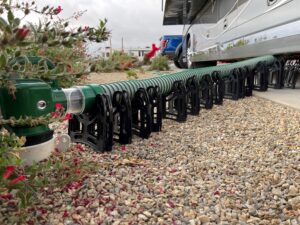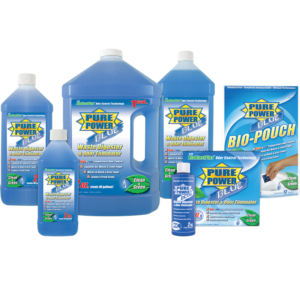Exploring the open road with an RV can lead you to breathtaking destinations. You have all the conveniences of home, right there with you. But….not every aspect of RVing is glamorous. Regularly maintaining and emptying your RV’s septic system may not be the most appealing task, but it is a necessary part of any RV adventure. Failing to care for and maintain this system can lead to some very unpleasant experiences.
Understanding your RV’s Septic System:
Recreational vehicles typically come equipped with three tanks located beneath the RV to ensure smooth operation:
Grey Water Tank: The grey water tank stores dirty water from your RV shower and kitchen sink. However, it’s worth noting that some older models or used campers might not have this tank.
Black Water Tank: The black water tank is often the most intimidating for new RVers. This tank stores waste water from the toilet. If your RV doesn’t have a grey water tank, all the dirty water will be dispensed into this tank.
Fresh Water Tank: As the name suggests, this tank holds fresh water, which is the water that comes out of your taps.
Problems can arise if these tanks are not properly maintained.
HOW OFTEN DO THEY NEED TO BE EMPTIED?
![]()
The frequency of emptying your RV tanks depends on your usage. There’s no fixed rule, but the general guideline is to wait until your tanks are about two-thirds full before emptying them. This creates a vortex which helps to remove the scum and eliminate build up.
The emptying frequency varies based on the number of occupants in your RV. If you’re traveling with a large group, you may need to empty the tanks every other day. However, if it’s just you and your spouse, emptying them once a week might suffice.

While some RVs have tank monitoring systems to indicate their fill levels, these sensors may not always work accurately, especially as time passes. Waste residue or paper sticking to the sensors can result in false “full” readings. This is more common than you might think so you’ll want to keep close tabs on your tank levels.
Proper Steps for Emptying RV Tanks:
Before your first waste water dump, ensure you have a sewer hose and gloves for protection. Follow these steps to empty your RV tanks correctly:
- Take the system out of its storage container near the park sewer inlet (which may be different than your usual method).
- Securely insert the elbow (or nozzle if you have a Waste Master sewer hose) [pictured above] into the ground sewer inlet; (If you have Waste Master, open the grey lever on the side of the nozzle.
- With the other end of the hose, go back to your RV where the sewer outlet is located at the side of the RV or in a wet bay or compartment.
- Remove the cap on the outlet and connect the hose. If you have the common bayonet hose fitting you will twist it on until secure. (If you have Waste Master, once the hose is inserted, cam down the green arms for a secure leak free connection)
- Start by emptying the black tank, which contains toilet waste water. Never dump this water anywhere except designated dump stations, which are clearly marked.
- Open the valve and allow the tank to drain completely. Close the valve tightly once you no longer hear any liquid flowing through the hose. It’s crucial to ensure the black tank valve is closed completely, as leaving it open can allow all of the liquid to drain out leaving solids in the tank which can cause the dreaded “plugged holding tank”.
- Once the black tank valve is shut, open the grey tank valve and let it drain. Again, close the valve tightly when done.
Some people make the mistake of leaving the grey tank valve open continuously outside the RV for drainage. However, it’s better to close the valve and only open it when necessary. Like we said earlier, you want a vortex when the water is flushing out to clean the side walls of the tank. Flushing the grey tank after the black tank helps remove any solids stuck in the sewer hose.
RESTORING THE SYSTEM FOR TRAVEL

- You’ll want to use the “first in, last out” rule here.
- Remove the fitting connected to the coach and install the protective cap on both the coach fitting and the male hose fitting.
- Walk the hose back to the ground sewer inlet, allowing the hose to collapse as you approach the park sewer inlet. (The Waste Master hose will stay together as it collapses making this part much easier)
- Lift the sewer fitting out of the sewer and put the cap on the outlet. (If you have Waste Master, close the gray lever which will stop any drips)
- Place the hose into the storage container. (If you have a Waste Master hose do this keeping the nozzle on top. This way next time you dump, the sanitary handle is easily accessible.
- Return the system to its RV storage location.
Maintaining Your RV Septic System:
Maintaining your RV septic system is just as important as emptying the tanks. The good news is, it’s not too difficult to keep it in good working order. Here are some tips:
First, make sure to use a potable water hose when filling up your fresh water tank. It’s also a good idea to insulate the hose in freezing weather and drain the tank in extreme heat.
To clean your fresh water tank, add 1/4 cup of household bleach for every 15 gallons of water in the tank. Run the water until you smell the bleach, then continue running until all the bleached water is out. Let the tank sit for 24 hours, then refill and run the water until the bleach smell is gone.
For the gray water tank, make sure to avoid putting food particles down the drain. They can cause a clog, even something as small as a pea.
As for the black water tank, don’t attempt to save water when flushing the toilet. Flush a generous amount of water down when flushing solid waste to keep the ratio of liquids to solids favorable or easily “flushable”.
HOLDING TANK TREATMENTS

Enzyme-based and bacteria-infused blends are the most effective type of tank additive for maintaining your RV septic system. These blends work by digesting odor-causing molecules inside the waste tanks, eliminating the odors instead of just masking them.
It’s important to avoid holding tank treatments that contain harmful chemicals like formaldehyde. Many state parks, campgrounds, dump stations, and local municipalities have banned RV holding tank evacuation because of the presence of these chemicals.
We recommend Pure Power Waste Digester. 
Keep in mind that RV holding tanks are living environments to some extent. Using antibacterial soaps, detergents, or DIY treatments can destroy the “good bugs” that help eliminate odors.
Still have questions? With over 25 years of experience in RV Waste Management, we’ve got you covered. 877 787-8833

